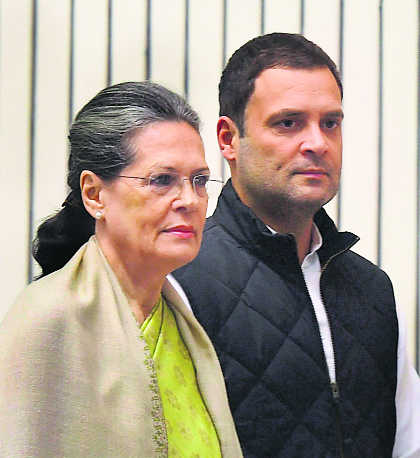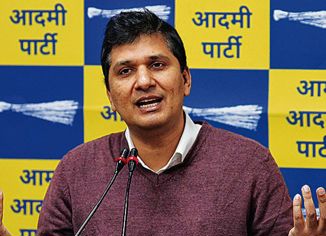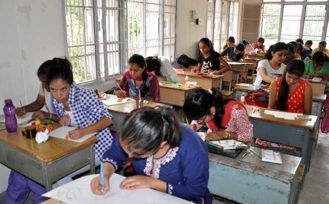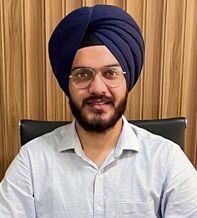
PASSING ON THE BATON: Sonia Gandhi and Rahul Gandhi. File photo
KV Prasad
Today, a new era dawns on the Grand Old Party — the Indian National Congress. A party, that essentially was a movement of the people and a chosen vehicle of Mahatma Gandhi to steer the country towards freedom from British rule. It will have a new President in Rahul Gandhi.
He will be the fifth from the Nehru-Gandhi family to take the leadership role at a juncture when the party is facing an existential crisis with its powerful political opponent working ceaselessly to deliver on its vow of a ‘Congress-mukt’ Bharat.
At 47, Rahul Gandhi is young, but not in the same league as both his grandmother Indira Gandhi in 1959 and father Rajiv Gandhi in 1984 were a shade above 40 when they became party president under different circumstances.
While the advent of a new elected leader on the political landscape of the country will receive all attention, this is also time to look at the legacy of the unprecedented two-decade journey of Sonia Gandhi, Rahul Gandhi's mother and his immediate predecessor.
For six years after the assassination of Rajiv Gandhi in 1991, Sonia Gandhi assiduously stayed away from politics despite intermittent pleadings by family loyalists. She chose an appropriate time to test the otherwise placid waters in the Congress. Her announcement to be an ordinary member brought great energy into the organisation that was turning moribund.
Sonia’s first official foray
The 1997 Kolkata AICC session was her first official foray where a vociferous section of the party workers chanted she be ushered on to the centre stage. That one step was like a giant leap for the party swiftly altering the existing arrangement. Within three months, she announcedthe decision to campaign and by March, 1998, the party jettisoned elected president Sitaram Kesri to put her in the saddle.
Sonia started with an unparalled advantage, taking over the reins of the party that was preceded by two spells of a not-so inspiring leadership. In one stroke, the last court of appeal for aggrieved Congress workers during the PV Narasimha Rao and Kesri regimes became the sole arbitrator of the party and its destiny.
Besides being the widow of the charismatic Rajiv and bahu of Indira, there were other factors that contributed to her easy acceptance by the people. It put an end to any chance of threat from within by conspiring colleagues and leaders who were past masters at the game of intrigue. The only jolt was the challenge by Sharad Pawar and company that found little traction in the Congress Working Committee.
Body of work
Her body of work is at various levels. Taking charge to turn around the electoral fortunes of the party, she despite commanding unflinching loyalty both from the ordinary karyakartas to strong regional and national leaders, evolved a new and distinctive style of consensual leadership.
Her arrival injected a dose of confidence and belief in the party that it could be nursed back to its pristine glory. The dynamic process culminated into crafting a coalition that dislodged the Atal Bihari Vajpayee-led National Democratic Alliance formation from power at the Centre.
Sonia’s intrinsic strength came from the fact that she was undisputed and most acceptable leader, permitting her the space to negotiate a working arrangement with the experienced old guard while allowing a new crop of leaders to emerge and consolidate their positions in the states.
If her mother-in-law was charged with reducing the CMs or state party chiefs as her puppets, Sonia rebuilt the party, encouraging regional leaders to work their way up. The likes of a YS Rajasekhar Reddy in Andhra Pradesh, Capt Amarinder Singh in Punjab or Bhupinder Singh Hooda in Harayana were allowed to emerge and consolidate their positions.
Her political baptism was literally by fire. She struck success early by leading victories in the Assemblies of Delhi, Madhya Pradesh and Rajasthan, but received a huge setback while handling high-octane manoeuvres, first by joining hands with Jayalalithaa to pull down the Vajpayee government and then her inability to install an alternative formation with the still-haunting claim of “we have 272 (MPs).”
With the benefit of hindsight, the stint in the Opposition permitted Sonia to hone her skills as a leader who dexterously built across the aisle contacts while securing her place within the party by installing Congress government across states.
While the Congress altered its 1998 Pachmarhi ‘Ekla Chalo’ line at Shimla in 2003, Sonia was pragmatic, admitting as early as 1999 that they would have to think of an alternative coalition platform to take on the NDA. By 2004 , several successes and reversals in states brought a new spring in her walk and she constructed the UPA edifice, weaving parties in the middle and those from the Left of Centre to confront the BJP.
For the first time, the country saw a unique division of labour, with the Congress president remaining as the bulwark for the party and allowing an experienced administrator in Manmohan Singh to steer the ship of the state.
Sonia remained the anchor of the Congress led-coalition she created and stood rock solid with the government in the first innings and to a lesser extent in its not-so glorious second term. The first four years went like a breeze with some innovative and socially conscious laws like MNREGA emanating from the National Advisory Council she headed while empowering the denizens with the Right to Information. And the nuclear deal that broke relations with the Left saw her stand steadfast behind PM Manmohan Singh, and the Congress hit a new high.
Even without the Left, the UPA re-merged stronger, but in the second term, the coalition government began to drift. Adding to the growing listlessness were serious charges of graft against some members of the coalition. Manmohan Singh who enjoys the reputation for his honesty came under attack both in Parliament and courts, but the party did little to arrest the slide or counter the growing perception of his being the head of a corrupt administration. Sonia as the chairperson of the all-powerful coordination committee could have checked the foibles of allies.
Adding to it was the indecisiveness of Rahul Gandhi to assume leadership when she wanted him to do so. Today, the journey of transition that began in 2013 ends. Ironically, the conditions and challenges that propelled Sonia Gandhi to first step into the political theatre in August 1997 have rearranged and resurfaced in a more virulent form when she is relinquishing the presidentship.
On Sonia refusing PM’s post
The saga of her not accepting the post of the Prime Minister is too well known to recount. Yet, an anecdote by K Natwar Singh autobiography One Life is Not Enough is worth mentioning. “Once I pulled Sonia’s leg on this, telling her that only two people in history had refused the crown, both Italians by birth. Who is the other, she asked. ‘Julius Caesar,’ I replied.”.


























